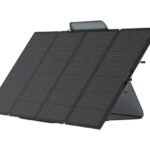To make the most out of your solar panels, you need the right equipment. One crucial component is the solar charge controller. In this article, we’ll explore what solar charge controllers are, how they work, and why they are essential for your solar power system.

What is a solar charge controller?
A solar charge controller is an electronic device that regulates the charging process of a solar battery bank. By carefully managing the flow of electricity between solar panels and batteries, it ensures optimal battery performance and longevity.
Installed between the solar panels and batteries, the charge controller monitors and controls the voltage and current levels during the charging process. This precise regulation prevents overcharging, undercharging, and other harmful conditions that can reduce battery life. The controller is specifically configured for the type of battery used, employing algorithms designed to maximise its lifespan.
- One of the primary functions of a charge controller is to protect the battery from damage. It safeguards against excessive voltage and current, which can occur during periods of high solar irradiance.
- Also, the controller prevents reverse current flow from the battery to the solar panels when they are not generating power.
- Some models incorporate temperature compensation too, adjusting the charging rate based on battery temperature.
It’s important to note that charge controllers are essential for off-grid systems, but you don’t need them for grid-tied installations. In grid-tied systems, excess power is usually fed back to the grid by the inverter.
Many modern charge controllers include user-friendly features such as digital displays or mobile app compatibility, providing valuable insights into system performance. By carefully managing battery charging, a solar charge controller plays a vital role in ensuring the efficiency and reliability of a solar power system.

Why do I need a solar charge controller?
A solar charge controller is an essential component of any off-grid solar system. Without a solar charge controller, your batteries would be at risk of overcharging, overheating, or even exploding in extreme cases. The controller ensures a steady and safe charging process, prolonging the life of your batteries and improving the efficiency of your entire solar power system. It’s an essential component that protects your investment and ensures you get the most out of your solar panels.
How does the solar charge controller work?
By regulating the electrical current flowing from the solar panels to the battery, a charge controller prevents overcharging and discharging, which can damage the battery. It does this by adjusting the voltage and current levels based on the battery’s state of charge.
There are three primary charging stages:
- Bulk Charging: The battery is discharged. So, the battery is rapidly charged using the full power output of the solar panels. This increases the voltage in the battery as it fills.
- Absorption Charging: Once the battery nears full capacity, the charge controller reduces the charging current to prevent overcharging, maintaining a constant voltage level. In other words, the solar charge regulator keeps the voltage slightly below the absorption voltage (around 14-14.5 V, depending on the type of battery), reducing the current until the battery is practically full.
- Float Charging: When the battery is fully charged, the controller switches to a low voltage (generally 13.5 V), trickle charge to maintain the battery’s optimal state without overcharging.
Any excess solar energy that cannot be stored in the battery is unfortunately wasted as heat because of the controller’s operation (Joule Heating).
Solar Charger Controller Types
The two main types of charge controllers are PWM (Pulse Width Modulation) and MPPT (Maximum Power Point Tracking). But for a better understanding of the operation of charger controller types, we would first have to understand what the MPP is.
What is the Maximum Power Point (MPP)?
Power in electricity is the rate at which an electric circuit transfers electrical energy. The unit of power is the watt (W). Larger units include kilowatts (kW), where 1 kW = 1000 W, and megawatts (MW), where 1 MW = 1000 kW. On the other hand, according to the Watt’s Law, the basic formula for electrical power (P) is:
P=V×I
where P is power in watts, V is voltage in volts, and I is current in amperes (amps).
Also, two essential tools to understand, evaluate and optimize the performance of solar panels are:
- The current-voltage (I-V) curve: This is a graphical representation of the relationship between the current (I) and voltage (V) output. So, the MPP is the point on this curve where the product of current (I) and voltage (V) is at its maximum. This means the solar panel is operating at its highest efficiency and producing the most power.
- The power- voltage (P-V) Curve: The power (P) curve is derived by multiplying current and voltage (P = I x V) at each point on the I-V curve. The peak of this P-V curve is the Pmax. This is the power output of the solar panel at the Mpp.

These are the curves of a 100-watt solar panel. In red, is the I-V curve. In green, is the P-V curve. We can also observe the following important points on the curves:
- Isc (Short Circuit Current): The maximum current a solar panel can produce when its terminals are shorted together (voltage is zero).
- Voc (Open Circuit Voltage): The maximum voltage a solar panel can produce when no current is flowing (the circuit is open).
- MPP (Maximum Power Point): The point on the I-V curve where the product of current (I) and voltage (V) is maximum.
- Pmax (Maximum Power): This is the maximum power the solar panel can deliver.
- Impp (Maximum Power Point Current): Impp is the current at which the solar panel produces its maximum power output. It is the current corresponding to the Maximum Power Point (MPP) on the current-voltage (I-V) curve.
- Vmpp (Maximum Power Point Voltage): Vmpp is the voltage at which the solar panel produces its maximum power output. It is the voltage corresponding to the Maximum Power Point (MPP) on the I-V curve.
Practical Example
Suppose we have a solar panel with the following specs:
| Max Power at STC (Pmax) | 100W |
| Open Circuit Voltage (Voc) | 22.79V |
| Short Circuit Current (Isc) | 5.31A |
| Optimum Operating Voltage (Vmpp) | 19.97V |
| Optimum Operating Current (Impp) | 5.01A |
This means that this solar panel can offer a maximum of 100 watts of power.
Let us remember that according to Watt’s law, P = V x I. In other words, this is:
Pmax = Vmpp x Impp.
So, in the case of this example, we have the following:
19.97 V x 5.01 A = 100 W
PWM (Pulse Width Modulation) Charge Controllers
A PWM controller directly connects the solar panel to the battery during the charging process. It uses Pulse Width Modulation to turn the connection on and off rapidly, adjusting the width of the pulses to control the amount of charge going to the battery. So, the PWM controller ensures that the battery is charged to the correct voltage. If the battery is nearly full, it reduces the pulse width to avoid overcharging.
However, a PWM (Pulse Width Modulation) regulator essentially works at the battery’s voltage level, which affects its overall efficiency and how it manages the charging process. In other words, the voltage of the solar panel is pulled down to match the battery’s voltage. This means that the PWM could be inefficient because the solar panel’s voltage is often higher than the battery’s voltage. For example, if you are charging a 12V battery, the solar panel will operate close to 12V even if its maximum power point voltage (Vmpp) is higher.
In conclusion, the PWM regulator doesn’t always operate the solar panel at its maximum power point (MPP) because solar panels typically generate maximum power at a voltage higher than the battery’s voltage. By not optimizing for this MPP, energy that your panels could harvest is lost, especially in varying sunlight conditions.

MPPT (Maximum Power Point Tracking) Charge Controllers
An MPPT controller constantly monitors the panel’s voltage and current to find the Maximum Power Point (MPP) where the panel generates maximum power. So, it adjusts the input from the panels to match the optimal voltage and current for maximum efficiency. Also, it uses a DC-DC converter to step down the higher panel voltage to the battery’s charging voltage while increasing the current proportionally.
MPPT solar chargers continuously monitor the voltage and current output from the solar panel to find and maintain operation at the MPP. To get this, it uses sophisticated algorithms and electronic components.
In summary, MPPT controllers have many benefits. By always operating at the MPP, MPPT chargers can increase the energy harvested by up to 30% compared to non-MPPT systems. Also, they adapt to varying environmental conditions, ensuring optimal performance throughout the day and across different seasons.
PRIMARY
The higher the system voltage, the more benefit you can get from an MPPT system.

Summary
PWM Pros
PWM Cons
MPPT Pros
MPPT Cons
KEY INFO
An MPPT solar charge controller could be the best choice if you live in a rainy and cloudy region. This is why this charge controller can maximize energy harvest under varying light conditions. Despite the higher initial cost, the increased efficiency and adaptability to fluctuating sunlight make MPPT controllers better for ensuring optimal performance in less-than-ideal weather.
Can I use a solar panel without a charge controller?
A solar charge controller is not always necessary, but I recommend it and it is often essential in most solar power systems with batteries. It would not be necessary:
- In the case of on-grid photovoltaic systems without batteries.
- Or also when you use very low-power panels, such as portable solar chargers for electronic devices.

Do I need a charge controller for a 100W solar panel?
Yes, in this case, you would need a solar charge controller. Suppose you have a 100-watt, 12-v solar panel. We recommend using the formula:
Power = Voltage x Current (Watt’s Law)
to know what type of controller we need. Since we know the power and voltage, the next step is to determine the current. Then, we rearrange the formula to be
Current = Power/Voltage.
In this case, with 100 watts and 12 volts, the calculation would be 100/12 = 8.33 amps. So, for a single 100-watt solar panel, a 10-amp charge controller would be necessary, with caution to round up for safety.




Leave a Reply